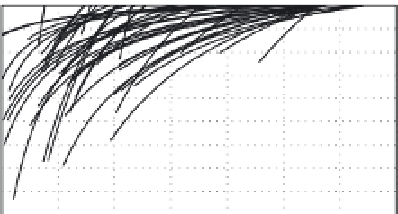Geology Reference
In-Depth Information
tectonic processes. Where tectonic fracturing
is more intense (see figure B), geomorphic
fracturing is commonly not seen. Such rocks
are interpreted to be sufficiently weak that
they fail by bedrock landslides, whose
frequency inhibits the development of a
weathered layer at the surface.
These observations underpin a simple
conceptual model (see figure C) in which
geomorphic fracturing propagates down-
ward into a rock column through time,
thereby increasing fracture density and
reducing rock strength. Such fracturing
should affect the erosional efficacy of many
surface processes. In sites where landsliding
is a major contributor to overall denudation,
this fracturing can weaken formerly strong
bedrock to the point of failure, such that
most landslides are shallow and occur within
this geomorphically weakened zone. In
contrast, where the underlying bedrock has
already been considerably weakened
by pervasive tectonic fracturing, landslides
of any depth can occur, and a highly
fractured, geomorphic surface layer is
uncommon.
Geomorphic
Fracturing
0
Land-
slide
Events
4
Temporal
Evolution of
Fracturing
mean depth
7.0±0.5 m
8
Fracture Density v Depth
12
Tectonic
Fracturing
average tectonic fracturing
w
/o geomorphic fracturing
w/ geomorphic fracturing
16
Low
High
0
0.1
0.2
0.3
0.4
0.5
0.6
0.7
B
C
Fracture Density
Fracture Density
B. Fracture-density profiles for about 70 sites in
Fiordland, New Zealand. Where a geomorphically
fractured layer is present, the mean fracture density
of the underlying, tectonically fractured bedrock
(0.05) is four-fold less than the mean (0.2) when no
geomorphic fracturing is observed. Strong underlying
rock apparently inhibits failure by landslides and
promotes geomorphic fracturing.
C. Geomorphic fracturing both propagates a fracture
front downward and increases fracture density over
time. Tectonic fracturing defines a “starting condition”
and, along with lithologic character, determines
whether a slope will fail by landsliding without
any further fracturing. Whereas deep landslides
can rupture beneath any geomorphically weathered
zone, shallow landslides may be restricted within it.
For example, chemical weathering can convert
micas and feldspars to clays or can dissolve min-
erals. Such processes weaken rocks and increase
their susceptibility to mechanical disaggrega-
tion. At the same time, mechanical breakdown
of rocks continually exposes unweathered mate-
rial and provides fresh surfaces for efficient
chemical attack. In temperate to alpine and
arctic terrains, a key mechanical weathering
process is frost cracking. The geomorphic effec-
tiveness of frost cracking is strongly dependent
on the presence of water and the time a parcel
of rock spends within a certain subzero thermal
window (Hallet
et al.
, 1991; Anderson, 1998;
Hales and Roering, 2007). Frost cracking can
dominate disaggregation processes and facili-
tate more efficient chemical weathering, even in
cool climatic regions. In most tectonically active
regions, mechanical weathering appears to
dominate locally measured erosion rates
(Box 7.1), and rates of dissolution are often
uncalibrated.

















































































































































